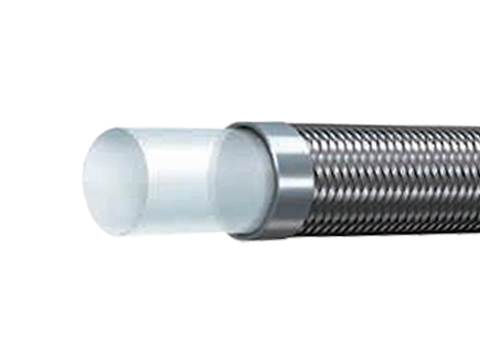2025-03-31 14:47:25
PTFE hose temperature resistance
1. What is PTFE hose?
PTFE hose is an industrial hose made of polytetrafluoroethylene (PTFE, commonly known as "Teflon") as the core material. PTFE is a high-performance fluoroplastic, known for its excellent chemical stability, temperature resistance and low friction characteristics, and is widely used in fluid delivery systems in harsh environments.
2. Core characteristics
Extreme temperature resistance:
It can work stably in the range of -40℃ to +160℃, withstand high temperatures of 300℃ for a short time, and adapt to various scenarios from refrigeration equipment to high-temperature reactors.
Chemical corrosion resistance:
It can withstand almost all strong acids, strong alkalis, and organic solvents (such as concentrated sulfuric acid, hydrofluoric acid, aqua regia, acetone, etc.), and is an ideal choice for the chemical industry.
Ultra-low surface adhesion:
The surface is smooth (the friction coefficient is only 0.04), which prevents high-viscosity media (such as glue and resin) from remaining and ensures the purity of delivery.
III. Typical structural design
PTFE hoses usually use a multi-layer composite process:
Inner lining: pure PTFE film, thickness 0.1~1mm, direct contact with the medium to ensure chemical inertness.
Reinforcement layer: stainless steel wire braiding or spiral winding to improve compressive strength (burst pressure can reach more than 6MPa).
Conductive layer (optional): carbon fiber or metal mesh, eliminate static electricity, used for flammable and explosive solvent transportation.
Outer protective layer: fluororubber (FKM) or modified FEP material, UV resistance and wear resistance.
IV. Main application areas
Chemical industry: transportation of corrosive chemicals (such as acids, alkalis, organic solvents).
Semiconductor manufacturing: transmission of high-purity electronic gases, photoresists, and etching solutions.
Food and beverage: pollution-free transportation of concentrated juice, edible oil, and food additives.
Biopharmaceuticals: pipeline connection of vaccine stock solution, sterile medium, and CIP/SIP system.
New Energy: Precise supply of lithium battery electrolyte and photovoltaic texturing liquid.
Environmental Protection Engineering: Waste gas treatment (VOCs), collection and emission of high-temperature flue gas.
V. Advantages and Limitations Advantages:
The service life is up to 5~10 years, far exceeding rubber and PVC hoses.
Low maintenance cost, no need for frequent replacement.
Support customized design (such as conductive, anti-bending, transparent observation window).
Limitations:
The cost of raw materials is high, and the initial investment is large.
The flexibility is slightly inferior to that of silicone hoses, and a protective cover needs to be installed when bending at a small radius.
VI. Selection and Usage Recommendations Media Matching: Confirm the fluid composition, temperature, and pressure range to avoid contact with very few incompatible substances (such as molten alkali metals).
Pressure Requirements: Select the reinforcement layer structure according to the working pressure (non-reinforced hoses can be selected for low-pressure scenarios).
Environmental Factors: UV-resistant outer sheaths are required for outdoor use, and low-temperature embrittlement risks should be noted in cold areas.
Installation Specifications: Avoid twisting or excessive stretching, and use special joints to prevent leakage.


Leave a Comment